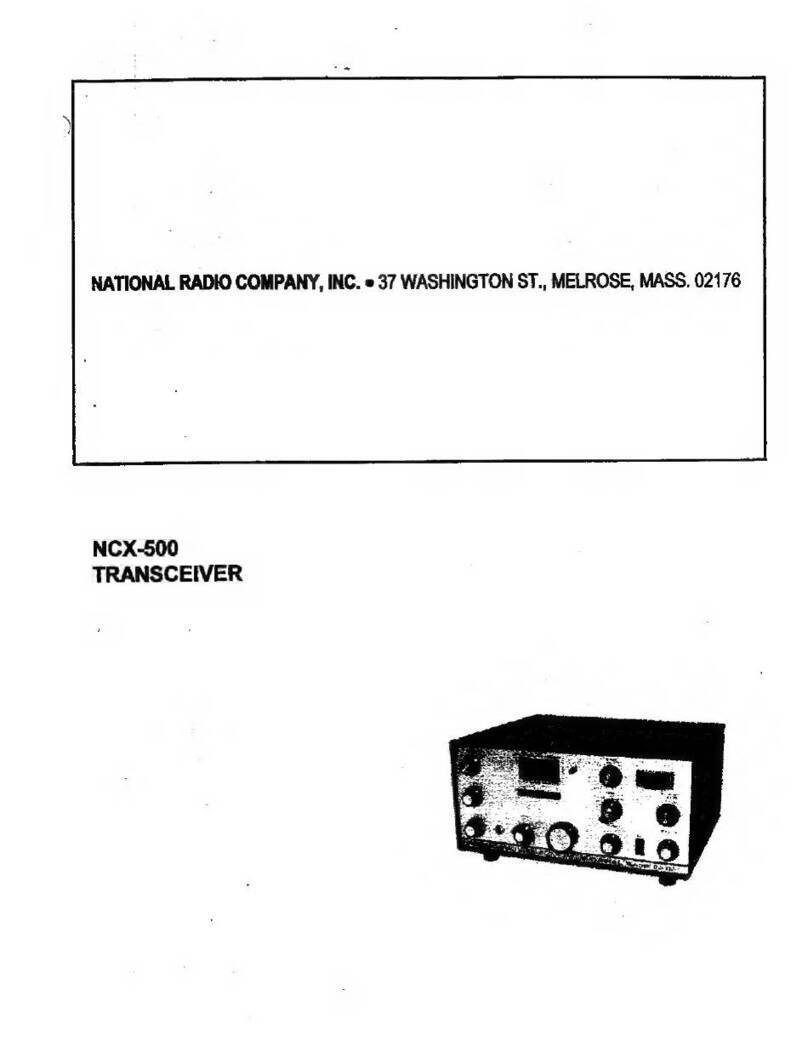in
paragraph
3.1.3. Assuming this setting has been
made
for
an
idling
current
between
50
and
60
rna,
it
should be possible
to
obtain a momentary maximum
off-resonance piate current
in
·excess
of
350
rna
when
the PA
TUNE
control is
rotated
away from
the
point
of minimum current.
If
700 volts
is
being properly
supplied
to
the plate circuit of the final amplifier,
and
the
EXCITER
TUNE
control
is
proper
ly
ad-
justed, this off-resonance
current
should exceed 350
rna.
If
this current
cannot
be achieved,
the
cause
should be found. Typical causes may include any of
the following: improper Bias setting, improper
EXCITER
TUNE
adjustment, low plate supply
voltage to
the
final amplifier under full load condi-
tions, low driver B+, defective final amplifier tubes
or driver tube,
or
improper alignment
of
the
exciter
stages resulting
in
low driving signal.
As
mentioned above, low plate supply voltage
to
the
final amplifier will frequently result
in
diffi-
culty
in
obtaining a suitable off-resonance current.
The
NCX-A
power supply is
rated
to deliver 700 volts
to
the
final amplifier with a 115 volt A.C. input.
The
NCX-D
power supply is
rated
to deliver 700 volts
to
the
plate circuit
of
the
final amplifier with a 14.0
volt
input
to
the power supply.
If
the A.C. line voltage
or
the
mobile battery supply voltage
is
low, the
power supply
output
wil
be
reduced.
Under
these
conditions,
an
off-resonance
plate
current
of
less
than
350 rna will probably occur.
This
will
not
impair
the
operation
of
the
NCX-5 transceiver, provided
that
the PA
LOAD
control is
not
adjusted for excessive
loading conditions.
In
no
event should
the
LOAD
control be advanced
so
that
the
plate
current
at
the
resonant
dip
exceeds
85%
of
the off-resonant plate
current, which is noted by momentarily
detuning
the
PA
TUNE
control.
In
many
instances
an
antenna
load
that
is outside
the 40
to
60
ohm
range
of
the
Pi network will be
used with
the
NCX-5. Antennas presenting this type
of impedance should,
if
at
all possible, be adjusted to
present a
proper
load
at
the
NCX-5
antenna
term-
nals.
This
can
be done through the use
of
matching
ne~works
and,
in
many instances, by simply tailoring
the length of
the
antenna
transmission line
to
modify.
its terminal impedance.
. Generally speaking, if the NCX-5 exhibits a
resonant
plate
current in
the
dip
in excess
of
300 rna
with
the
PA
LOAD
control rotated
to
its full counter-
clockwise position, the
antenna
load impedance
is
below 40 ohms.
If,
on
the
other
hand,
the
resonant
dip is still less
than
300 rna
with
the
PA
LOAD
con-
trol rotated
to
its full clockwise position,
the
antenna
load impedance
is
above 60 ohms.
It
is possible to
modify
the
Pi network
output
capacitors
of
the
NCX-5
to
take care of some misloading
in
these
directions.
With
the
PA
housing. removed, a group
of four
mica
capacitors will be seen just below the
BANDswitch
and
connected between
the
BAND-
switch
and
chassis. These capacitors, C-37 (3.5
Me),
8
C-38 (7
Me),
C-39 (14
Me),
and
C-182 (21
Me)
are, respectively, 1000, 470, 220,
and
220 pF.
They
appear
in parallel
with
the front
panel
PA
LOAD
control as shown
on
the
schematic
diagram
and
may
be altered to extend
the
range
of
the Pi network.
If
the
load impedance
is
too low, the capacitance should
be increased. A good quality silver mica capacitor
may be used for this purpose.
It
is
advisable
to
use
as large a case size
on
these capacitors as
can
be
obtained.
There
is of course some interaction of
tuning
between the
PA
LOAD
control
and
the
PA
TUNE
control.
If
load
matching
as described in
the
pre-
ceding
paragraph
is
attempted,
it
is possible
that
the
tuning
of
the
PA
TUNE
control will
be
shifted to
a point where this control will
no
longer cover
the
entire
amateur
band.
In
this event,
it
will
be
necessary
to
use external matching techniques.
It
is also possible
that
the
antenna
line will introduce
an
inductive
or
capacitive component
to
the
NCX-5
antenna
termi-
nals.
In
this event, there may be also a shift
of
the
PA
TUNE
control so
that
it
will
not
tune
over
the
entire amateur band. Again
it
will
be
necessary
to
alter
the
antenna
impedance by means
of
an
external
matching network
or
correction
of
the
antenna
diffi-
culties. SSB operation should
not
be
attempted
.unle~
the NCX-5 is properly matched
and
loaded because
severe distortion
can
result with
any
improperly
matched SSB transmitter
or
receiver.
3.2.5
CARRIER
BALANCE
CONTROL
During
the
tune-up
(with
the
FUNCTION
switch
in
the
TUNE
position), one deflection elec-
trode
of
the 7360 balanced
modulator
is
grounded,
creating complete carrier unbalance. Having accom-
plished proper transmitter tune-up,
it
is necessary
to
use the
CARRIER
BALANCE control
to
properly
set
up
the
NCX-5
transceiver for operation
on
SSB,
AM,
or
CW
operation.
For
SSB operation, the
NCX-5
is placed
in
a
transmit condition
either
by
the
push-to-talk
button
or
the
MOX-OFF
switch.
In
either
event,
the
MIC
GAIN
control should be
in
full ccw position
so
that
no audio modulation will occur.
The
CAR-
RIER
BALANCE control
is
then
adjusted for
minimum meter indication.
This
meter
reading should
be between
50
and
60 rna
if
the
BIAS control
is
properly adjusted.
When
the
CARRIER
BALANCE
control
is
properly set,
it
may be left
in
this position
for all subsequent SSB operation. A more precise indi-
cation
of
CARRIER
BALANCE control setting may
be obtained either by using
an
oscilloscope connected
to
the
antenna
line
or
by listening
to
the
carrier
on
a separate receiver.
With
proper carrier balance
and
tuning
of
the transceiver circuits, voltage
on
the
an-
tenna
line should
not
exceed 0.5 volts peak-to-peak
as indicated
on
the
oscilloscope.
For
AM
operation,
it
is
nec~3sary
to
adjust
the
CARRIER
BALANCE control
either
cw
or
ccw





























